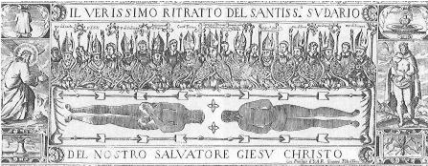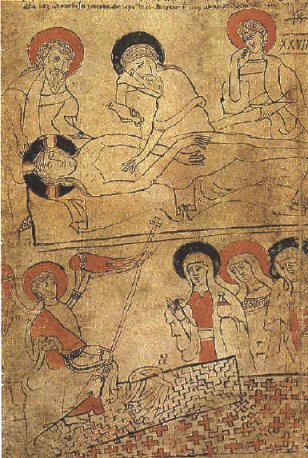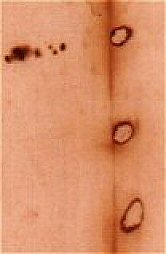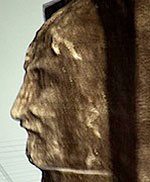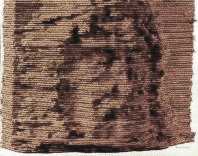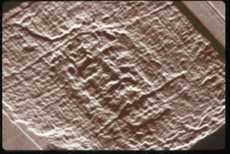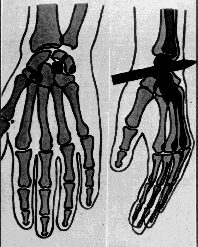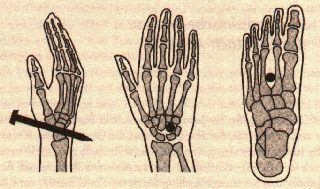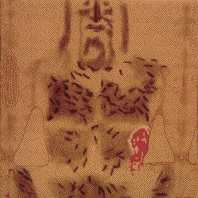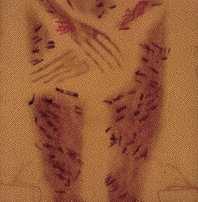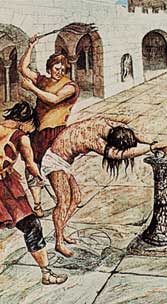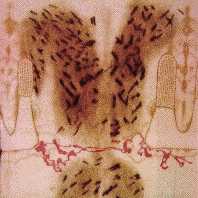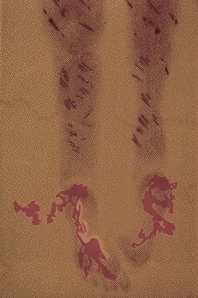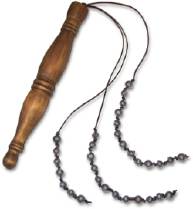|
|
|
 |
 |
 |
 |
 |
 |
 |
 |
 |
 |
 |
 |
 |
 |
 |
 |
 |
 |
 |
|
The Shroud of Turin
Isn’t is wonderful that there are still secrets, which no one can explain and and even the biggest skeptic are
geting problems to explain the image. Since over 100 years scientist try to find the secrets of the shroud of Turin. A own branch of science has been developed called “Sindonologie” to study the 4.36 m
long and 1.10 m wide sheet of linen
And even after ten of thousands hours of analysis, the biggest mystery of the shroud remain unsolved -questions like how was the image created or how did it get its
three-dimensional information get on the image?
|
|
|
|
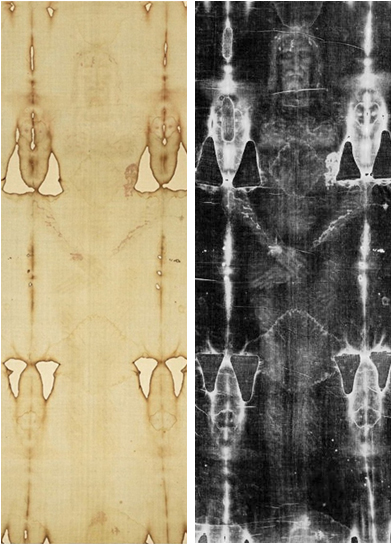 |
|
|
|
The shroud left as „Original“ and right as „Fotonegativ”. The big spots on the image are fire damages from the yea 1532.
|
|
|
|
If you see the shroud the first time you probably first will the the big fire damages on it. Only a closer look will show you the faint image of a naked man who has the stigmata of the
crucified on his body. The body can be seen in front and back view, in a remarkable arrangement: both images are put togheter in head to head position. The image has no contours, it’s like a strange
shadow image.
On 28 May 1898 a Turin councilman and lawyer Pia Second, a respected amateur photographer, was invited to take a foto of the shroud -the first time in history. And neither he
nor anyone else thought that this image will become a sensation.
The first negative image, made on glass plate, slowly became visible in the developing bath. When he noticed the image, he almost dropped the glass plate, and this information
was spread all over the world. The image on the shroud is a photo negative! Only now, since we are able to reverse the color of a image by foto development, we are
able to the all the information in this image of a crucified man. How is that possible?
Early of the year 1898 there were some trivial conflicts between representatives of science: The historians scientist wanted to prove by medieval documents, that the shroud was made
in the first half of the 14th century by painted "in a very ordinary way."
But how should a painter of the 14th Century have painted a negative image? A half of a millennium before the invention of photography? An
absurd idea! This negative character can not be found below the traces of blood. They are not only darker than the body image, they have a clear visiable contour. Anyone who looks without prior knowledge and without
prejudice to this image must say: This is not "art". It’s not made by human hands. It must be something else.
|
|
|
|
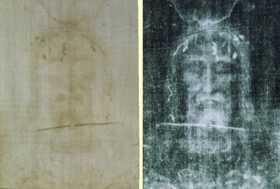 |
|
|
|
The face in „original“, and right as “negativ” image
|
|
|
|
The Radiocarbon-Dating
|
|
|
|
On 21. April 1988 scientists cutted a 7 inches long and 1 cm wide ice of the bottom from the shroud, divided it into three pices and sent it to three different laboratories in
Zurich, Oxford and Tucson. Those laboratories were assigned to find the age of those pieces with the help of radiocarbon specific method. The radiocarbon method is a method to determine the age of carbonaceous
organic materials. C14 is based on the radioactive decay of carbon-isotope. For exampl, after 5370 years the original amount of C14 decreased by about half. With this methode the age of organic material, such as
Natural textiles can be measured.
The official publication of the test results done in accordance with long circulating rumors on 13 October 1988, were presented by Cardinal Ballestrero
in Turi. The content was extremely poor: the shroud must be made in the time period between 1260 and 1390th full stop. "Science has spoken."!
|
|
|
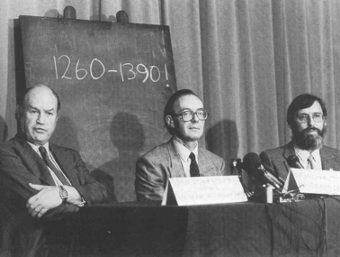 |
|
|
|
Professor Edward Hall, Dr. Michael Tite, and Dr. Robert Hedges during the press conference on 13 October 1988, at which they presented the results of the C-14
analysis. "The shroud is certainly made in the time period 1260-1390, that was the result. The exclamation mark behind the time periode gives an indication of the emotions that exists during the
presentation.
|
|
 |
 |
|
The fact that there were several contrary results was not even mentioned. But soon after the publication of this result doubts have been registered. An important argument was that the
edge of the cloth was repaired by darning in the past, with darning cotton (fabric) which are much younger. The reason why the cloth was fixed by darning was the fire damage in the year 1532 (the big spots
which are still visible on the shroud). To strengthen the shroud it was sewn on a nother cloth. That such repairs took place, is sufficiently documented. As far as we know nuns took over the task to repair the
damaged shroud, and they understood their work extremly good. They fixed the holes by darning and sewing the precious relic on to a new lining in ordner to stabilize it. This lining is among the shroud experts
generally know it as the “Holland lining”. Even up to the twist of yarn the lining completely corresponds to the original. The repaired cloth is only in one point differed to the original: the
age. The test samples for the radiocarbon analyse were taken from exactly such a repaired patched-up in the shroud.
In April 2004 researchers from the University of Padua found a very fine and much less detailed picture on the back side of the cloth. It shows only somewhat of a imprecise
face and hands. They found this image on the back side of the shroud during the restoration of the shroud in Turin. They also found 30 repair patches and also the so-called “Holland linen” which was put
there nearly 500 years ago.
Another criticism was the fact that the pice of linen for the analysis was taken from an area which was visibly contaminated. It was taken from an area
in the corner where people touched the shroud during public exhibitions. Heat, sweat, soot from torches and candles have been working through the centuries especially at these points on the cloth. An the big fire
damage in the year 1532 infued the hole shroud with smoke of this century.
|
 |
 |
|
The analysis of the fabric
The linen is “fishbone shape” patterned -a special hand-loom was necessary to create the linen. This
hand-loom was not known in the 14 Century of France. From the area of Syrian however some very old hand-looms from the time of Jesus Christ are preserved. Also some old fabric filaments were found which have not
been produced in Europe.
|
 |
 |
 |
|
 |
 |
|
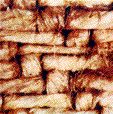 |
|
|
|
The analysis of the pollen
As part of a scientific investigation of the shroud in the night of 23 November 1973 the
Zurich scientist and criminologist Dr. Max Frei toke some dust samples from the surface of the shroud. He was interested in the pollen, which he found in the dust samples. These pollen are smaller than a hundredth
of a millimeter and often have a bizarre appearance. They are also not easy to distinguish, but may be assigned by an expert who is able to allocate the plant species. Most of the pollen found by Dr. Frei are
unknown by European palynological. On five expeditions to the Middle East and in nine years of laboratory work, Dr. Frei was able to identify the pollen of 58 plant species. Only for one species he was not been
successful. It was completely unexpected that only 17 of these 58 species were located in France and Italy, where the shroud was permanently stored since the 14th century.
All other pollen and plant species provide a consistent picture: they are all from the Middle East, some from Constantinople. There is a clear focus: not less than 44 plant species are
characteristic of the flora in and around Jerusalem.
Microscopic analysis
No brush strokes are visible on the shroud (as would be typical for a painting). Also no
color pigments were detected. The image has no contour lines (like a painting). Near to the fire marks the pale color of the image is unchanged. The image seams to be stable to heat.
The “coloration” of the fabric of the shroud can only be seen very slightly at the top of the fabric surface. At no position the “coloration” is deep inside
the fabric infiltrated. Even at places which appeare more dark to the naked eye -for exapmle the eyebrows, nose, etc., the “coloration” did not infiltrate the fabric more deep. The dark color of the
fabric is not producedin the way that a single fibers is darker than the other, it is caused by a density increase of the fibers.
At no position the “coloration” of a single fibre tranfered it’s “coloration” to a none “coloration” neighboring fibre. To paint such
thin fibres separately without thouching a neighboring fibre is technically not possible!
There was no spread of ink through the capillarity of the pores. The darker color, which makes up the body image is rather based on chemical changes of
the fibers by oxidation and dehydrogenation: oxygen uptake and hydrogen loss. A generally accepted explanation of why this happend is not found yet. There is nothing comparable!
|
|
|
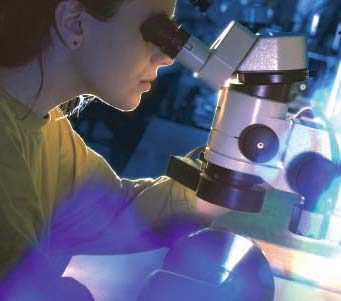 |
|
 |
 |
|
The chemical analysis
The micro samples of blood stains from the shroud showed that it is human blood group AB.
Except the color pigments from blood no other color pigments were found, as it would be typical for a painting. We found no organic dyes. The color of the shroud fibers can’t be extracted by any known solvent,
which would be typical for organic dyes.
Produce of a three dimensional image
The anatomist Y. Delage (Paris) suggested in the year 1902 that the
intensity of image on the shroud is inverse proportional to the distance from the body to the shroud. So, where the body touched the shroud the most strongly coloration can be found, the greater the distance, the
weaker the coloration. At a certain distance it falls to zero.
This finding was almost forgotten for decades. But it was rediscovered by a image analyzer developed for the space research program. Jackson, a professor of theoretical physics
(Los Alamos, USA), used a very detailed photograph of the shroud for this analysis. To his surprise a 3D-Image appeared on the TV-screen. The bright/-dark shade of colors are converted into height information and
the result is a three-dimensional image. The degree of brightness corresponds to the position of the body: the salient points (nose, knuckles of the fingers) are darker, the deeply lying positions (orbits, arm side
and the rest of the face) are brighter: so, it is now fact that the image on the shroud is formed by a real three-dimensional body. No painter can use color and shadows so precise that the computer can
calculate an exact three-dimensinal image. It is not possible for a painter to create an distortion-free three-dimensional image.
The image on the shroud is also not, as often shown in the medi a real impression
of a person. A real impression of a person would lead to distortion, because a human body surface is not flat, but has almost the shape of an "irregular cylinder”.
The should shows a non-distorated photo negativ image with real 3D-dimensional information. It is not possible, that an image become a negativ of its
own. There is nothing like it ever found in history and still it is not understood how is image was produced. The thesis, Leonardo da Vinci could have made this image is totally stupid. From science point
of view not worth to comand such nonesense.
|
 |
 |
|
The person to be Crucifixed was first nailed to the cross which was lying on the ground (both feet were nailed with a single nail), then the cross was placed on the vertical. Because
the body weight had to be carried by the arms breathing was very difficult and the crucified Christ had to fight with the risk of suffocation. Only by stretching the legs of the crucified he could straighten his
body to breathe (ignoring the pain that caused by the nails in feets).
It was practice if the death of the crucified should be accelerated, it break his legs so the crucified could not raise his body for breathing. In John's Gospel it is
specifically mentioned: "When they came to Jesus, they saw he was already dead, and so instead of breaking his legs one of the soldiers pierced his side with a lance; and immediately there came out blood and
water. "(John 19, 33+34). This was prophesied by the way even in the Old Testament:
(2 Mose 12,46): "You shall not break his leg."
And in another passage (Zechariah 12:10): "when they look on the one whom they have pierced". The puncture with the lance, mentioned by John, can be seen on the
shroud. It can be seen on the right half of the thorax, between the fifth and sixth rib. According the shape of the wound it must been caused a spear ( as Maria Grazia Siliato writes in" And the shrous is
real", Heyne Verlag, Munich 1999).
The mistreatment coused by the terrible scourging could have been identified by forensic doctor. There are wounds of at least 100 canings, which document an incredible pain. For
forensic doctor’s the shroud is one of the most dreadful archaeological findings.
An analysis of the reddish substance (the blood stains on the shroud) in a sample of 180 Micon showed the clear result that it is "blood"! The blood has a very large
amount of bilirubin, which occurs when a body is extremly abused over a long time periode.
The image of the bodyshows even more details which usually aren’t recognize on the first few. It was not possible in the more than 90 years of
research on the shroud the find a mistake against anatomy, physiology and pathology (many nonbeliever where searching for such mistakes on the shroud)
The image shows a significantly lower right shoulder which is a typical occupational disease for a carpenter by trade.
|
 |
 |
|
Historical evidence
A reconstruction of the "Itinerary" of the shroud is a big challenge for any historian, because the
evidence are not easy to proof and there is a big field of speculations. Nevertheless, the follwing reconstructed itineary of the shroud through many countrys and centuries can be seen as fact. The shroud itself
shows a journey - spores of plant species from Jerusalem, from Anatolia and from Constantinople where found on it, as already explained.
|
 |
|
|
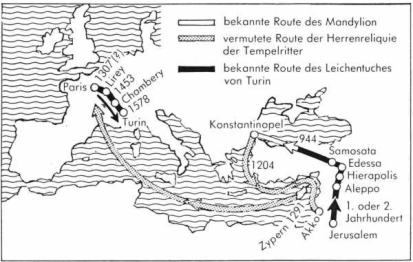 |
 |
 |
|
1. Century
Disciples of Jesus brought the shroud to Edessa (modern name “Urfa” in eastern Turkey) to King Abgar for safety reasons. It was placed above the city
gate of Edessa.
2. Century
Abgar grandson turns back to the ancient religion believing in demons -the shroud is in danger now. For that reason it was bricked into the walls of the city and was
vorgotten over the time.
year 525
The shroud was found around the year 525 together with the Veil the Volto Santo in the city walls of Edessa. It played a important rolle during the siege of the
city in the year 544, as the historian Evagrius Scholastieus wrote in the year 594: "When they didn’t know what to do, they brought the image created God created which was not made by human hands ...
". This image of Jesus became a template for all representations of Jesus in art. So the shroud and the Veil where the baseline for all icons in history.
945
The emperor of the Eastern Roman Empire bought the shroud of Edessa and saved it from the advancing Arabs. The shroud is now kept in Constantinople.
|
|
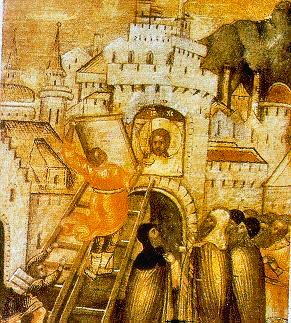 |
|
|
 |
|
|
|
|
 |
 |
 |
 |
 |
 |
 |
 |
 |
 |
 |
 |
|
Rediscover of the Mandylion in Edessa
|
|
|
|
year 1150
A Hungarian Embassy visited Constantinople. They showes him the holy shroud of Jesus Christ. A miniature of the shroud was made, which is currently in the National
Library of Budapest called Codex Pray. The amazing thing is, that this picture shows L-shaped points (old burns) on a position where it is still visible today. This amazing image also shows Jesus with four
fingers, like the shroud. This is a clear indication that this image whants to shows the shroud wich we call today the shroud of Turin.
13. April 1204
Constantinople was conquered by the Crusaders and then looted. The shroud gets lost.
year 1306
King Philip of France shatters the Order of the Templars. In protocols is mentioned that the templars where worship a linen which shows something like "the
form of a male head with a big beard". The Templars, however, were able to keep their secret -is never revealed were the linen with the image was hidden. After years, a branch of the Knights Templar was found
in England, on which an image with a face was “painted”, which looked simular to the the shroud.
year 1357
The widow of the knight Geoffroy de Charny had financial problems and decided to show the shroud public. Immediately many pilgrims went there and the shroud
becomes so popular that the there a no daubt for historical evidence since that time. All evidence of the shroud are documented since this time periode.
year 1452
A descendant of the de Charny family gives the shroud to Louis of Savoy, where later a king of Italy was born in that family.
year 1532
(In 1502, the Shroud is given a permanent home in the Royal Chapel of Chambery Castle. In 1532, a fire breaks out in the chapel,
which is seriously damaged by molten silver that fell on one corner of the folded cloth, resulting in eight roughly symmetrical burin patters and two burn lines running the length of the cloth.
year 1898
A photo is taken from the shroud the first time in history.
It is a fact now that the original image is a kind of “photo negative”. The shroud becomes famous for scientists and ii is the start of the modern researchon the shroud.
year 1983
Former King Umberto of Italy gave the shroud as a present to the Vatican just before his death.
12. April 1997
The shroud almost became sacrificed by an arson attack. As shown, all evidence point out that the shroud is authentic. There is only a one person mentioned in history who was crucified, had a crown of thorns and who was also flagellate. The person on the shroud can only be Jesus Christ our Lord. In the media (on TV at prime time) nonsense can be seen like statments that the shroud is made by "Da Vinci". A serious documentary with real facts about the shroud does not fit well to our "enlightened" world, where no room is left for unexplainable things. And now the is a second unexplainable cloth from the tomb of Jesus called the Volto Santo of Manoppello (please read about the Volto Santo on the next main page)
|
|
|
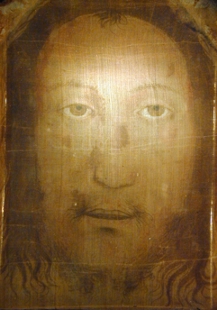 |
|
|
|
The holy face, the Volto Santo from Manoppello
|
|
 |
 |
|
Theories on the origin of the image on the shroud of Turin and the Volto Santo
On TV or in Newspaper (at least in Germany) the majority opinion is that the shroud of Turin is just a painting by Leonardo Da Vinci. In their opinion it can not be an impression
image of Jesus (originated in the tomb of Jesus), because an impression image of an body would lead to distorted image. They shows an Video on TV that a human face is not aflat surface, but has the shape of an
"irregular cylinder”. Their conclusion: the impression image must have been created by an artist. The was shown on a report in one of the biggest TV chanel stations called ZDF. Here is a statement form
ZDF:
Missing cylindrical distortion: The face of a human has the geometry shape of a cylinder. The impression image of an human face must therefore be much
broader than it is the case on the image of the Holy Face of Manoppello (the Volto Santo). The missing cylindrical distortion speaks against the origin of the "Volto Santo" from the tomb of Christ. From
anatomical point of view the "Volto Santo" is clearly a two-dimensional representation of a face. It must be made by an artist by painting - this is the resume of a specialist in plastic surgery.
|
 |
 |
|
Unfortunately, such "silly" arguments are broadcast in prime time.
As the impression image on the shroud created? Sure, there are many theories, but if we eliminate those which are nonsense we can find the one which is most realsistic theory.
I can give you an verifiable theory, but for Christians the miracle of the resurrection of Jesus might lead to a explanation
for these two images (the shroud and the Volto Santo). The blood on the shroud had become separated from the impression image onto the shroud. The blood must have been on the shroud before the impression
image was created. Where blood is found on the shroud, there is no impression image to find. Before we try to find a explanation lets have a look at the flowing questions: What do we know about the resurrection
of Jesus?
The resurrection of Jesus was a very different "Resurrection" as the one where Jesus awaken Lazarus from dead (see John 11, 17). Although Lazarus was dead since four days,
Jesus took him by a miracle back to life. Lazarus was in his physical body back to life. In his dead body his heart started to beat again and he regained consciousness. Jesus resurrection was quite different. He did
nose rise in his “old” physical body, after the resurrection he had a "new body" in a "new life". Jesus had a “special” body after his resurrection, a body with special
skills as described in the Bible. Let have a look at the first scene after the resurrection of Jesus from the Gospel of John chapter 20, 11:
11 But Mary stood weeping outside the tomb. As she wept, she bent over to look into the tomb; 12and she saw two angels in white, sitting
where the body of Jesus had been lying, one at the head and the other at the feet. 13They said to her, ‘Woman, why are you weeping?’ She said to them, ‘They have taken away my Lord, and
I do not know where they have laid him.’ 14When she had said this, she turned round and saw Jesus standing there, but she did not know that it was Jesus. 15Jesus said to her,
‘Woman, why are you weeping? For whom are you looking?’ Supposing him to be the gardener, she said to him, ‘Sir, if you have carried him away, tell me where you have laid him, and I will take him
away.’ 16Jesus said to her, ‘Mary!’ She turned and said to him in Hebrew, ‘Rabbouni!’ (which means Teacher). 17Jesus said to her, ‘Do not hold on to me,
because I have not yet ascended to the Father. But go to my brothers and say to them, “I am ascending to my Father and your Father, to my God and your God.”
In chapter 14 it is said “When she had said this, she turned round and saw Jesus standing there, but she did not know that it was Jesus.” The
appearance of Jesus must have change a bit. Lets have a look a John chapter 21:
|
 |
 |
 |
 |
 |
 |
 |
 |
 |
|
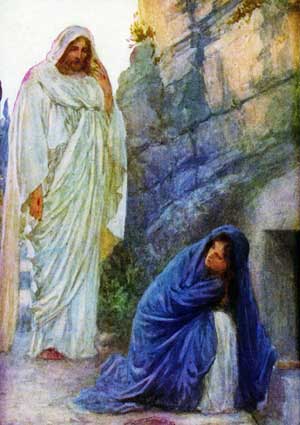 |
|
|
|
After these things Jesus showed himself again to the disciples by the Sea of Tiberias; and he showed himself in this way. 2Gathered
there together were Simon Peter, Thomas called the Twin,* Nathanael of Cana in Galilee, the sons of Zebedee, and two others of his disciples. 3Simon Peter said to them,
‘I am going fishing.’ They said to him, ‘We will go with you.’ They went out and got into the boat, but that night they caught nothing. 4 Just after daybreak, Jesus stood on the beach;
but the disciples did not know that it was Jesus.
The Gosples didn’t realize their own Lord after the resurrection. His appearance has changed. If we compare
the face on the shroud of Turin with the face of the Volto Santo, it seams to be younger and the markes of the torture are gone on the Volto Santo. But another strange text can be found in the Bible by John
Chapter 20, 19-20:
19 When it was evening on that day, the first day of the week, and the doors of the house
where the disciples had met were locked for fear of the Jews, Jesus came and stood among them and said, ‘Peace be with you.’ 20After he said this, he showed them his hands and
his side. Then the disciples rejoiced when they saw the Lord.
chapter 20, 26-28:
26 A week later his disciples were again in the house, and Thomas was with them. Although the
doors were shut, Jesus came and stood among them and said, ‘Peace be with you.’ 27Then he said to Thomas, ‘Put your finger here and see my hands. Reach out your hand and put it in my side. Do not doubt but believe.’ 28Thomas answered him, ‘My Lord and my God!’
It is reportet in the two chapters that the door was shut, and Jesus came and stood among them. I think that was
mentioned quite aware that the door were locked and that Jesus could enter the room. With this knowledge, that Jesus could pass through locked doors, we now should understand what happend during the resurrection of
Jesus:
The body of the dead Jesus was wrapped in linen and layed in the tomb. His face was
covered with a very thin delicate fabric woven from a silk (maybe from Mary Magdalene). At the moment of resurrection, the whole body of Jesus has transformed into pure energy (according to Albert Einstein matter
can be converted into energy). A mysterious force comes out of the body and illuminates the tomb. What's happend in that moment of transformation of the body of Jesus which was still under the linen
clothes? The shroud must have penetrated the body of Jesus and it simply dropped though the body onto the ground of the tomb, see figures below. This maybe coused the impression image on the shroud and also on the
delicate fabric silk which is now known as Volto Santo. Thoses images are a kind of "snapshot" of the resurrection. The linen cloth was in direct contact with the body and formed a photographic negative
image, which showes the physical dead body of Jesus. The silk cloth was on top of the linen, gives a “snapshotlater” just moment later of the resurrection, showing the healed face of Jesus. Maybe a
kind of radiationproduced the two images.
|
|
|
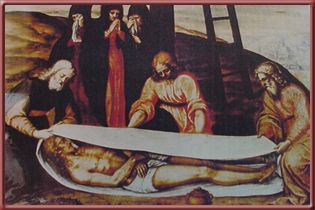 |
|
|
|
 |
|
|
|
YouTube Video of the shroud from von Barrie Schwortz
|
|
 |
 |
|
That radiation can produce images was observed for the first time after dropping of the terrible atomic
bomb in Hiroshima. As a result of radiation-lightning a so called called "permanent shadow" was found by scientists on buildings. The flash of the bomb also produced a slightly reddish tint discolored
concrete. A similar process may have caused the emergence of pictures at shroud. Perhaps the two burial clothes are “written by light”.
A scientifically proven fact how the images were produced will probalby never be
found. It would be to easy to find evidence of God. So far all ambitions to prove that the shroud is only fake and made by painting comes to nothing. The shroud is real! For faith it is not important to know how the
shroud of Turin or the Volto Santo was produced. Important is only to recognize that the two images are a gift from God for us. It can help us to convert faith into assurance.
|
|




